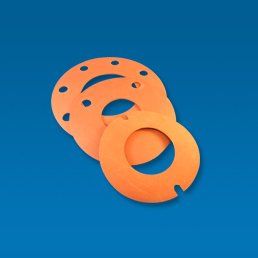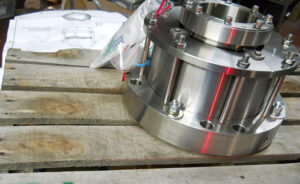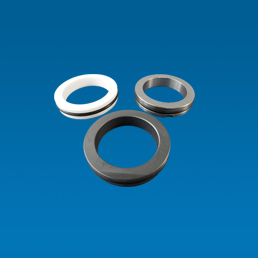As their name implies, O-rings are doughnut-shaped with a round cross-section. They’re designed to create a leak-proof seal between two other components and prevent the unwanted escape of fluids or gas. They’re also considered a type of gasket, but the main difference is that O-rings are commonly used in extremely high-pressure environments, where a rubber gasket may be prone to failure.
Since they’re low-cost, easy to produce, reliable, and easy to fit, you can find them in a wide variety of machinery and equipment. O-rings are typically made from an elastomer, so they’re known as rubber O-rings. This guide will discuss more O-rings to help you understand how they work and their applications in the industry.
How Do O-Ring Seals Work
O-rings are placed in a channel or groove between two surfaces that will be pushed or mated together. The elastomer in O-rings sits between the two components and becomes compressed to create a tight seal.
The O-ring is distorted inside its groove as internal pressure applied to the joint increases. As a result, the overall sealing force improves up to a limit. However, beyond certain pressure and under more dynamic workloads, this can cause seal failure. It’s crucial to maintain the right balance between the seal’s size, material, and working environments to ensure they fulfill your requirements.
Using O-Ring Seals
Commonly present in valves, connectors, pumps, and cylinders, O-rings help seal joints between two separate parts to retain gases and liquids inside them. You can use them with pneumatic, hydraulic, dynamic, and static components that make them a versatile solution to various engineering issues.
The key strength of an O-ring type seal is that after the compression forces are removed, and the joints are disconnected, it will return to its regular shape. However, repeating this process over time will affect the uniformity and resilience of the materials and the seal’s shape. Eventually, you will have to replace it with a new one to keep the two surfaces tight.
Under pressure, the O-ring will move in its channel towards the seal’s lower pressure side, making it move more tightly against the outer and inner walls created between two surfaces. This will create a tighter seal up to a point, but putting more stress on an O-ring than it can handle will lead to excessive deformation and leakage.

O-Rings for High-Temperature Sealing
High-temperature sealing O-rings are designed to resist extreme heat while providing a reliable seal between two components. This makes them ideal for environments such as chemical processing, oil and gas refineries, turbo engines, aerospace engineering, and more.
The most popular high-temperature O-ring material choices include hydrogenated nitrile, silicon, poly-acrylate, and nitrile.
O-Rings for High-Pressure Sealing
O-rings are typically designed to resist high pressure and work at optimal levels. The design and manufacturing of O-rings depend on selecting specific materials for improved performance under specific conditions.
Given the fluids’ internal pressure stays below a given O-ring’s contact stress rating, leaks are impossible to occur, even under high-pressure conditions.
Causes of O-Ring Failure and their Prevention
Since O-rings are designed to solve a particular problem for an application, O-ring selection must be based on their functionality and the industry’s requirements. Here are the most common causes of O-ring failure that will help you understand how to prevent similar problems in the future.
![]()
Compression Set
This is one of the most common O-ring failures that occur when an O-ring is squashed into a flat-side oval. Even after removing the stressor, it’s less likely to recover as it has set into the deformed shape permanently. Compression set is caused by contact between an incompatible fluid and O-ring, improper gland design, and using an O-ring with poor compression properties or at high temperatures.
Using an O-ring material with high-temperature resistance and a low compression set will help prevent the failure. Examine the gland design to ensure the O-ring isn’t over-compressed. If required, you can also reduce the system’s operational temperature and minimize extreme functional heat build-up at the seal face.
Nibbling and Extrusion
The main cause of extrusion is high stress forcing the O-ring material into the clearance gap between the mating components. The high pressure causes the clearance gap to open and close, catching the O-ring between sharp edges. The physical damage caused is called nibbling.
The issue can be prevented by reducing machine tolerances to lower the chances of clearance. For sealing applications with unique geometries, using custom-made O-rings may be a suitable option.
Abrasion
Abrasion is caused by repetitive contact between the housing and the O-ring surface. Too much friction wears down the O-ring’s sliding contact faces, leading to wear lines or deep scratches and breaks. Abrasion is more common in dynamic applications involving reciprocating, rotary, or oscillating motion.
Ensuring the correct surface finish and adequate lubrication on metalwork can help prevent the problem. Check the system fluid for contaminants and consider installing filters or wiper rings.
Chemical Degradation
Various chemicals react to certain O-ring materials. When the material is unable to resist the effects of a chemical, degradation occurs. Excessive stretch or compression, mechanical stress, and elevated temperatures can increase the risk of chemical attacks.
Choosing the best O-ring material based on the chemical is key to preventing degradation. For improved chemical resistance in high temperatures, consider using the perfluoro-elastomer (FFKM) material.

Looking for Mechanical Seal and Service?
Robco of America offers O-ring seals and gaskets that are custom designed for your needs. Our products are 100% manufactured, assembled, and tested in the US to help you avoid tariffs. Our product range includes mechanical seals, gaskets, mechanical packing, and heat resistance textiles. Check out our services and contact us by calling 1-800-662-0585 or emailing us at [email protected].
About The Author
The author is an experienced engineer with over 12 years of experience in the mechanical seal and service industry, providing reliable engineered sealing solutions. He has worked with some of the biggest companies in the United States, providing technical assistance and onsite support to the manufacturing and processing industries.


